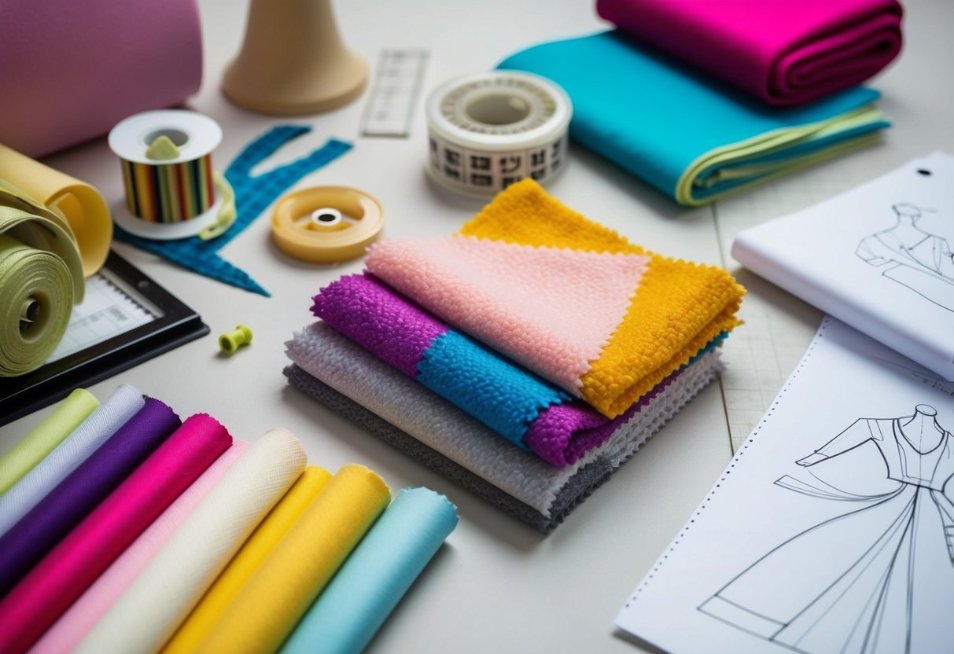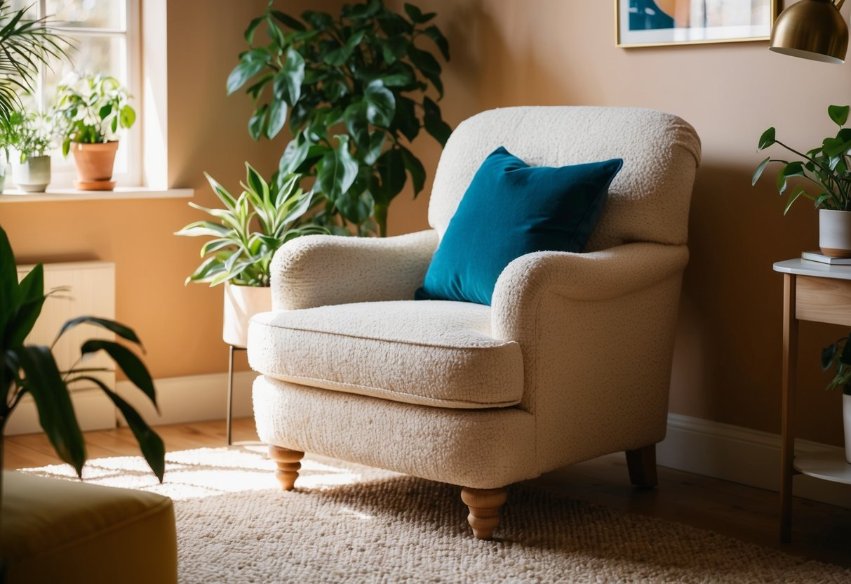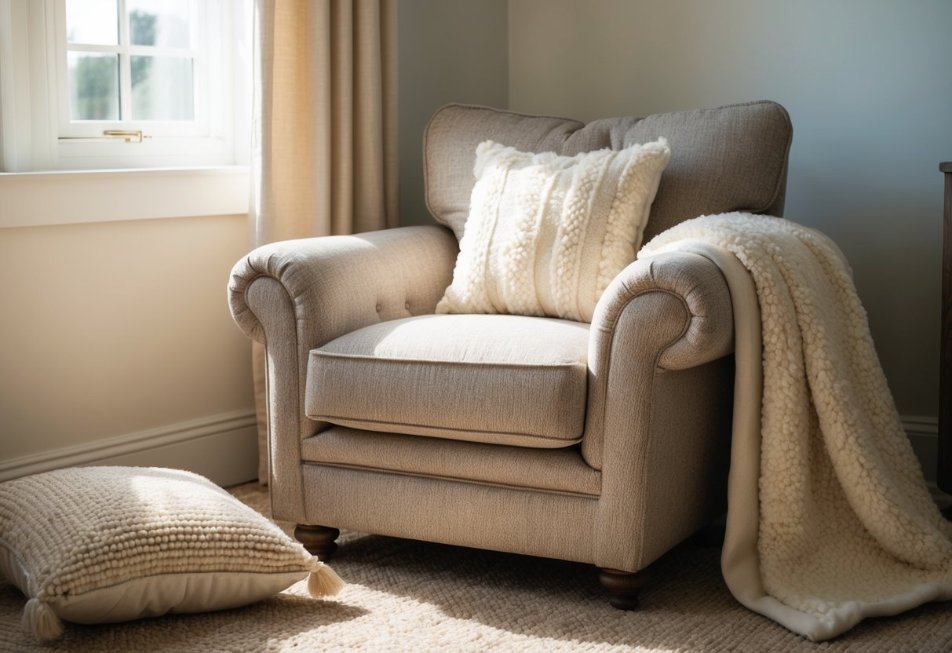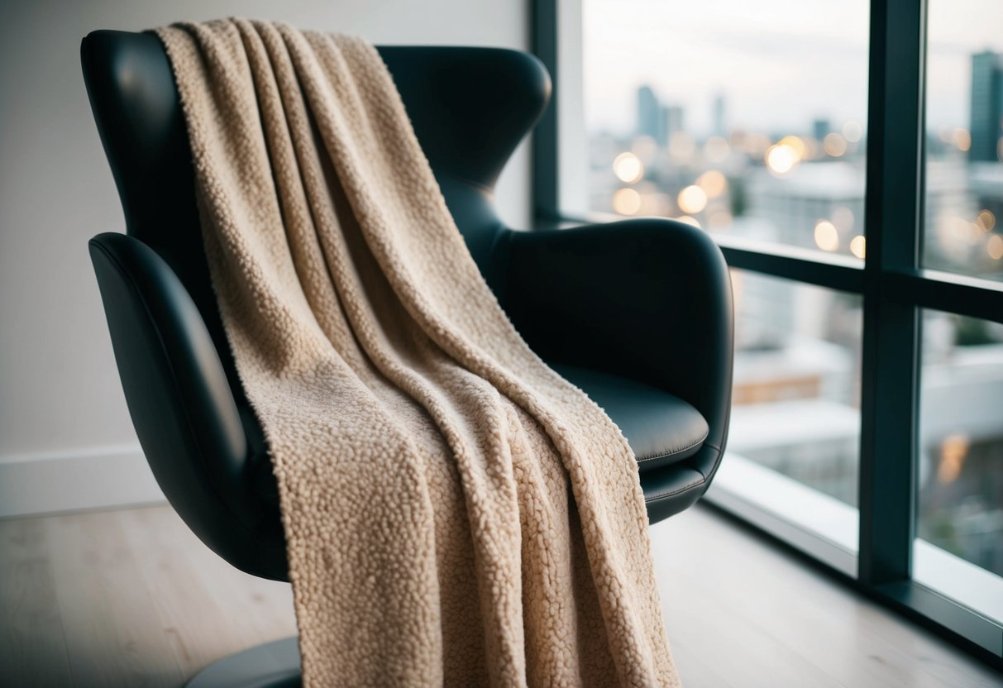Exploring the luxurious texture, unique construction, and versatile applications of this trendy looped fabric
Bouclé fabric gets its name from the French word for ‘loop’ or ‘curl’, which perfectly describes its distinctive looped texture. This unique textile features small, curly loops woven into the yarn, creating a nubby, textured surface that adds depth and visual interest to any piece it covers.
The fabric has captured the attention of interior designers and fashion enthusiasts alike, appearing on trendy accent chairs, sofas, and decorative pillows. Its popularity stems from its ability to blend cosiness with sophistication, making it a favourite choice for both modern and traditional spaces.
On This Page
Key Takeaways
- Bouclé fabric features a distinctive looped texture that adds warmth and dimension to furniture and clothing
- The material comes in both natural and synthetic fibres, offering versatility for different uses and budgets
- Its timeless appeal suits various design styles whilst providing comfort and durability
Understanding Bouclé
Bouclé fabric stands out for its distinctive looped texture and rich history in textile manufacturing. The unique yarn construction creates a soft, nubby surface that adds depth and visual interest to any garment or piece of furniture. https://www.youtube.com/embed/Iqnea6ggITc
Definition and Origin
The word bouclé comes from the French word “boucler,” which means “to curl”. This term perfectly describes the fabric’s signature appearance, which features small, continuous loops in the yarn.
Bouclé emerged in the mid-20th century as a prized textile in high fashion. The fabric gained significant popularity when Coco Chanel incorporated it into her iconic jackets in the 1950s.
Characteristics of Bouclé Yarn
Bouclé yarn consists of at least two threads: a core thread and an effect thread that creates the distinctive loops. These loops can vary in size and regularity, creating different textures.
The fabric can be made from both natural and synthetic fibres. Common materials include:
- Wool
- Cotton
- Polyester
- Silk
- Blended fibres
The texture of bouclé is notably soft and provides both comfort and sophistication. The raised, nubby surface creates depth and visual interest while maintaining a plush feel.
Bouclé in Fashion

Bouclé has been a prominent textile in fashion since the mid-20th century, making its mark in both high-end designer collections and everyday wear. The fabric’s distinctive looped texture adds sophistication and visual interest to clothing.
Bouclé Clothing
Bouclé fabric works brilliantly in a range of garments, from coats and jackets to dresses and skirts. The textile’s warmth and durability make it especially suitable for outerwear and autumn-winter collections.
Wool bouclé remains the most popular choice for clothing, offering natural insulation and a luxurious feel. Cotton and silk bouclé provide lighter alternatives for spring and summer garments.
Fashion designers often choose synthetic bouclé blends for more affordable ready-to-wear pieces. These modern versions maintain the classic texture while offering improved wash-ability and wear resistance.
Iconic Fashion Pieces
The Chanel bouclé jacket, created in the 1950s, stands as the most recognisable bouclé garment in fashion history. This jacket-and-skirt set revolutionised women’s fashion by combining comfort with elegance.
Modern fashion houses continue to embrace bouclé, creating contemporary interpretations of classic pieces. The fabric appears in:
- Tailored suit sets
- Cropped jackets
- A-line dresses
- Structured coats
Designers pair bouclé with smooth fabrics like silk or leather to create textural contrast in their collections.
Interior Design Applications

Bouclé brings both visual interest and physical comfort to interior spaces through its distinctive curled texture and plush feel. The fabric has proven especially valuable in modern design for its ability to add warmth without compromising sophistication.
Furniture and Upholstery
Bouclé fabric creates an inviting softness on large furniture pieces like sofas and accent chairs. Its durable loop construction makes it ideal for high-use seating areas.
The iconic Womb Chair, designed in 1948, helped establish bouclé as a premium upholstery choice. Today, the fabric appears frequently on:
- Dining chairs
- Living room sofas
- Armchairs
- Ottomans
- Bench seating
Many designers choose bouclé for statement pieces in neutral colours like cream, white, and grey. The textural depth creates visual interest even in monochromatic schemes.
Home Decor and Accents
Smaller decorative items offer simple ways to incorporate bouclé’s luxurious texture into existing spaces. Throw pillows and blankets in bouclé add tactile comfort to seating areas.
Popular bouclé accent pieces include:
- Cushion covers
- Decorative throws
- Upholstered footstools
- Headboards
- Window seat cushions
The fabric works equally well in modern and traditional settings. Its natural depth creates subtle shadow play that adds dimension to solid-coloured pieces.
Textural Elements and Visual Appeal

Bouclé fabric features distinct loops and curls that create a three-dimensional surface pattern. The material’s unique construction results in a rich, tactile experience that transforms furniture pieces into visual focal points.
Creating Visual Interest
Nubby texture and raised loops define bouclé’s signature appearance. The fabric’s surface consists of small, tightly-woven knots and curls that catch light differently across its surface.
The textural richness comes from its specialised yarn construction. Two or more strands twist together, with one strand wrapping loosely around a core thread to create its distinctive bumpy surface.
This dimensional quality makes bouclé ideal for adding depth to simple furniture designs. The fabric transforms flat surfaces into engaging, touchable elements.
Colour Variation
The most popular bouclé options come in neutral shades, particularly off-white and cream tones. These light colours help highlight the fabric’s natural shadows and depth.
Natural light interacts beautifully with bouclé’s varied surface, creating subtle shifts in tone throughout the day. The fabric’s loops and knots catch light differently, producing gentle variations in shade even within solid-coloured pieces.
While neutrals dominate, bouclé also appears in soft pastels and rich earth tones. Each colour choice emphasises the fabric’s inherent texture in different ways.
Bouclé’s Versatility and Elegance

Bouclé stands out as a versatile textile choice for both fashion and home decor. Its distinctive looped texture adds sophistication to any piece, from clothing to furniture.
The fabric’s elegant appearance comes from its unique construction using bouclé yarn, which creates a rich, textured surface. This special yarn technique produces small loops that add depth and visual interest to the material.
In fashion, bouclé shines in classic jacket designs and formal wear. Its refined texture pairs beautifully with tailored trousers or pencil skirts, creating polished, professional looks.
The material gained significant prominence in mid-century modern design. The iconic Womb Chair from 1948 showcased bouclé’s potential in furniture upholstery, cementing its status in interior design history.
Today’s designers value bouclé for its adaptability. The fabric works equally well in:
- Elegant coats and jackets
- Sophisticated upholstery
- Luxurious home accessories
- Stylish soft furnishings
- Contemporary furniture pieces
Care and Maintenance of Bouclé

Proper care of bouclé fabric extends its lifespan and maintains its distinctive looped texture. Regular maintenance and gentle cleaning methods help preserve the fabric’s appearance whilst preventing damage.
Preventing and Handling Snagging
Bouclé’s looped texture makes it prone to snagging. Keep jewellery, sharp objects, and rough surfaces away from the fabric to avoid pulls and snags.
If a snag occurs, never cut or pull it. Instead, gently work the loose thread back into the fabric using a needle or crochet hook. For larger snags, seek professional repair.
Tips to prevent snagging:
- Use soft throws or cushions as barriers between bouclé and rough surfaces
- Remove jewellery before handling
- Keep pets’ claws trimmed
- Store bouclé items separately from other textiles
Cleaning and Storage Tips
Regular gentle brushing with a soft-bristled brush removes dust and maintains the fabric’s texture. For spills, blot immediately with a clean, white cloth – never rub.
Cleaning guidelines:
- Use mild soap and lukewarm water for spot cleaning
- Always test cleaning solutions on a hidden area first
- Air dry naturally, away from direct sunlight
- Avoid machine washing when possible
Store bouclé items in a cool, dry place. Use breathable garment bags for clothing and ensure furniture pieces are covered with clean, cotton sheets when not in use.
Synthetic and Natural Bouclé Fabrics
Bouclé fabric comes in both natural and synthetic varieties. Natural bouclé can be made from wool, cotton, or linen.
The most common natural bouclé is wool-based, which provides excellent warmth and breathability. Natural fibres create a luxurious texture that closely resembles traditional sheepskin or sherpa materials.
Synthetic bouclé uses materials like polyester or acrylic to create the same looped, textured appearance. These versions tend to be more budget-friendly and easier to maintain than their natural counterparts.
Mixed-fibre bouclé combines both natural and synthetic materials. This blend creates a fabric that balances durability with comfort whilst maintaining the signature textured appearance.
Care requirements vary between types:
- Natural bouclé needs gentle cleaning
- Synthetic versions are often machine washable
- Both types should be checked for specific care instructions
The colour range includes:
- Classic neutrals: White, beige, cream
- Bold options: Various bright and deep shades
- Natural tones: Undyed wool colours
Significance in Modern Design
Bouclé has become a dominant force in contemporary interiors, with designers embracing its versatile texture for both residential and commercial spaces.
The fabric’s popularity stems from its ability to add warmth and visual interest to minimalist designs. Many interior designers pair bouclé furniture with clean lines and neutral colours to create inviting spaces.
Home decor enthusiasts appreciate bouclé’s adaptability, as it suits various styles from modern to traditional. The textile works particularly well in home offices, where it adds comfort to task chairs without sacrificing professional appearance.
The iconic Womb Chair, designed by Eero Saarinen, helped establish bouclé as a luxurious choice for upscale furniture. Today’s designers continue this legacy with curved sofas and accent chairs.
White and cream bouclé pieces remain especially sought-after, offering a perfect balance of texture and sophistication. These neutral options create focal points in living spaces while maintaining design flexibility.
The material’s durability makes it practical for daily use, which explains its growing presence in:
- Living room seating
- Dining chairs
- Bedroom furniture
- Decorative cushions
Frequently Asked Questions
Bouclé offers distinct features and applications across home decor and fashion. Common queries focus on its materials, textures, proper pronunciation, and potential limitations.
What are the main uses of bouclé?
Bouclé throws and pillows add cosy texture to living spaces. The fabric works well for upholstered furniture, particularly armchairs and sofas.
Modern homes frequently showcase bouclé sofas as statement pieces. The material also appears in fashion items like jackets and accessories.
From what materials is bouclé typically produced?
Wool serves as the traditional base material for bouclé fabric. Many modern versions incorporate cotton, silk, or synthetic fibres.
Manufacturers often blend different materials to enhance durability and reduce costs.
How is bouclé yarn characterised?
The fabric features a distinctive bumpy texture created by looped yarns. These loops vary in size and tightness.
The unique construction creates a soft, plush feel against the skin.
What distinguishes bouclé clothing?
Bouclé garments offer warmth without excessive weight. The textured surface creates visual interest and depth.
The fabric drapes well and maintains its shape effectively.
How should one pronounce ‘bouclé’ correctly?
The word ‘bouclé’ comes from French, meaning ‘curled’ or ‘looped’. It is pronounced as ‘boo-clay’.
Many English speakers say ‘boo-kul’, though this differs from the authentic French pronunciation.
What are the potential drawbacks of using bouclé fabric?
The looped texture can snag more easily than smooth fabrics. Regular maintenance helps prevent pulled threads and damage.
The fabric may show wear in high-traffic areas of furniture. Light-coloured bouclé requires more frequent cleaning to maintain its appearance.

